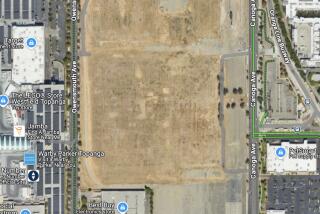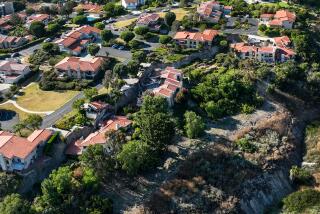Dig Near ‘Lost Village’ Site Yields Few Artifacts, Developer Reports
A developer whose property has become mired in controversy because it is across Ventura Boulevard from the “Lost Village of Encino” archeological site announced Tuesday that pre-construction archeological tests had yielded only a few artifacts of no apparent significance.
Archeologists and neighborhood activists, some of them staunch slow-growth proponents, have argued that the project’s proximity to the “Lost Village” greatly enhanced its chances of containing important artifacts--and the site warranted careful testing before any construction began.
But experts who dug at the defunct Pic ‘N’ Save shopping center last week identified no more than a tool scraper, stone flakes and fragments of small animal bones, items they determined to be of no significance, according to developer Ricardo Capretta.
David Van Horn, the Orange County archeologist hired to conduct the tests, declined to comment. But one of three other archeologists who reviewed the tests, William J. Wallace of Redondo Beach, confirmed Capretta’s account.
Capretta acknowledged the reported results were good news to his Gardena-based firm, Katell Capretta Partners, whose plans to build a 140,000-square-foot office building near the northeast corner of Ventura and Balboa boulevards have been delayed by the outcry over possible destruction of buried Indian artifacts.
Capretta said the controversy has stymied efforts to pre-lease the building and so far has delayed the $35-million project three months at an estimated cost of $100,000. He said his development firm undertook the tests, even without city orders to do so, largely in the hope of settling the ongoing dispute.
“We just felt that any speculation would haunt us,” said Capretta, who declined to disclose the tests’ cost but called the procedure expensive.
According to Capretta, Van Horn’s team systematically dug 28 large trenches in the former shopping center’s parking lot and bored eight slender holes inside what was the Pic ‘N’ Save store. The trenches and “auger bores,” which were a minimum of six feet deep each, created a grid of sample excavations known as a boundary test.
Van Horn’s findings were reviewed by a panel of three archeologists including Wallace, Franklin Fenenga and Clement Meighan, who were described by colleagues as three of the most experienced and well-respected archeologists in the state. The tests were monitored by an American Indian representative, Richard Angulo of Thousand Oaks.
Capretta said his firm would follow Van Horn’s recommendations that an archeologist monitor grading and other earth-moving operations during construction in case additional artifacts are found.
The “Lost Village” site was so named because the discovery there of human remains and more than a million artifacts make it a strong candidate to be an Indian village described in the journals of 18th-Century Spanish explorers, which was “lost” to modern archeologists who hunted fruitlessly for its ruins for years. It was discovered during a construction project at the southeast corner of Ventura and Balboa boulevards.
The site has since been developed into an office building and the artifacts are in storage.
The new project across the street is scheduled to be discussed July 24 by the city Building and Safety Commission. Capretta said he would release Van Horn’s study to the commission, which was asked to review the project by neighborhood activists who contend the Building and Safety Department overlooked its location within an archeologically sensitive area.
Kathy Lewis, an Encino resident who lobbied for archeological tests such as those conducted, said she was satisfied and praised the developer for voluntarily undertaking the test. Lewis, who has monitored the project for the Encino Property Owners Assn., said she was reassured by the credentials and reputation of the archeologists involved in the study.
But the leader of a rival homeowners group, Gerald A. Silver of Homeowners of Encino, said he would not trust the press release of a developer and demanded that the city review Van Horn’s findings.
“Someone has to monitor and audit the work of the developer,” said Silver, a well-known opponent of commercial construction along Ventura Boulevard. “It simply won’t be acceptable for the developer to hire the people he wants to hire with no oversight on the part of city agencies.”
Silver, whom Capretta blamed for delaying the project, also said he would call for further environmental studies on the proposed building’s effect on traffic and air quality.
More to Read
Sign up for Essential California
The most important California stories and recommendations in your inbox every morning.
You may occasionally receive promotional content from the Los Angeles Times.










